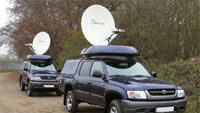Satellite trucks
Satellite trucks have been around for nearly 30 years, and the early U.S. behemoths with their 3m-plus diameter C-band antennas are a far cry from the latest compact low-cost 1.2m Ku-band auto-pointing SNG uplink systems fitted onto a small SUV.
The evolution of SNG has been marked by a number of changes stemming from major developments such as the introduction of the use of Ku-band satellite capacity in the 1980s and the switch to digital compression in the 1990s. Since the beginning of this decade, we have seen the development of the use of carbon fiber, the decrease in the amount of uplink transmission power required to operate with the current generation of satellites, and most recently, the use of automation to facilitate the deskilling of the uplink process.
However, recent developments in the VSAT market have now redirected SNG. (SNG is a subset of VSAT, though apart from having an antenna and using a satellite, there is generally little else in common.) In the period following 9/11, it quickly dawned on the civil contingency and homeland security community in the United States that they had allowed themselves to become complacent in their reliance on conventional telecoms infrastructure. Thus was born a new market for satellite communications.
Driven by this demand, a handful of manufacturers targeting the transportable VSAT market developed low-cost vehicle-mounted uplink systems. These systems relied on technology, including GPS, to automatically aim the antenna at the correct satellite rather than rely on human skill. Once on-site, a terminal can be quickly set up by personnel whose main job function is unrelated to uplinking.
Manufacturers have come close to the limits of the laws of physics in terms of how small and light they can build SNG systems, and they face an existing market that is almost saturated. The principal broadcasters are mainly into replacement cycles rather than extensive new purchases, as budgets are increasingly being squeezed to produce more output for more outlets.
Occasional use trucks
In order to expand the market by offering products at a lower cost, a few SNG manufacturers have focused on modifications to these transportable vehicle-mounted VSAT systems, as they are not manufactured to the quality required for the high usage cycle of a heavyweight newsgathering operation. An experienced SNG manufacturer can adapt a vehicle-mounted VSAT system to the modest requirements of the more occasional uplinker, and because these systems are designed for non-skilled personnel to operate, they are ideal for new entrants.
The professional video industry's #1 source for news, trends and product and tech information. Sign up below.
“Enhanced” motorized VSAT systems open up the SNG market to low-budget broadcasters that had previously been inhibited from venturing into SNG because of the high costs of the systems. So, for instance, a number of European SNG system manufacturers and system integrators have exploited the potential of the Middle East, Africa and newer member countries of the EU as areas of growth — not by selling the same premium-level product that they would typically sell to a major network or uplink service provider, but instead by offering a product that fits a more limited budget.
Automation deskills truck operations
Integral to the development of these low-cost transportable VSAT systems has been the implementation of automated deployment and aiming of the antenna to the target satellite. With innovative methods of locating and verifying the target satellite to be used with GPS location and DVB carrier identification, these systems are characterized by maximum automation and minimal manual control.

This results in a red button/green button style of operation, where parking the vehicle and pressing a single button initiates a sequence that deploys the antenna from its stowed position to then search and lock onto the desired satellite. Once the transmission is completed, another button push shuts down the system and stows the antenna back down for travel. These systems rely on always using the same satellite, with its position and parameters are stored in software.
By taking advantage of these low-cost motorized VSAT systems (typically costing below €20,000), using smaller power amplifiers (employing the higher sensitivity of the latest generation of geostationary satellites), and lower cost MPEG-2 encoders (because the technology is at the end of its development life cycle), manufacturers can offer a complete SNG system at 60 percent to 70 percent of the cost of a typical conventional product, combined with minimal operational skill level requirements.
The result is systems being offered at prices unheard of just five years ago, and the cost of operation, in real terms, is also lower than it has ever been. This has opened up the market to even the smallest TV station being able to afford to own and operate its own SNG truck. Freelance camera and edit crews are now able to find the money to add a small SNG system to a shoot and edit van to offer a one-stop shoot, edit and uplink package, making their services more sellable to news operations.
Future SNG developments
So what's ahead for SNG? Obviously, HD is the first thing to spring to mind. However, there has been a reluctance among broadcasters to rush into HD newsgathering for reasons relating to editorial, technical and financial issues. Perhaps of more interest is the concept of interconnecting a number of remote uplinks to form a network of newsgathering resources, rather than each working in isolation to a single destination.
The development of MPEG-4 H.264 and the introduction of the new DVB-S2 standard heralds a new era in SNG technology, as currently HD SNG is predominantly achieved by using MPEG-2 at very high data rates and hence large bandwidths. In turn, this has led to a renaissance in the use of the large antenna/amplifier combinations not seen since the days of analog uplinks.
This situation is not likely to continue in the long term, as the introduction of H.264 DVB-S2 encoder/modulators designed for SNG and remote event coverage should enable a return to similar antenna/amplifier combinations currently used for MPEG-2 SD transmissions.
The combination of MPEG-4/DVB-S2 can achieve bandwidth savings of close to 50 percent compared with MPEG-2/DVB-S transmissions. Apart from cost, however, two technical issues are really holding back adoption of MPEG-4/DVB-S2 — latency and chroma resolution.
H.264 broadcast encoders are currently available only in 4:2:0, mainly due to the limitation of current chip-sets. But the prospect of offering 4:2:2 processing leads to the second limitation of moving to H.264 — latency. We've become used to comparatively low delays in processing of MPEG-2 signals; most MPEG-2 encoders offer latency in the 100ms range. Currently MPEG-4 encoders processing at 4:2:0 are in the 400ms to 700ms range, depending on the transmission bit rate. This is unacceptable, particularly for live two-ways between the studio and the reporter.
The VSAT market is dominated by the use of large numbers of low-cost fixed terminals. Therefore, the antennas typically cost around a few hundred euros rather than the tens of thousands of euros that lightweight carbon fibre, precision-engineered, fast-deploy SNG antennas cost. Small fixed satellite terminals are used for retail, banking, corporate and government applications operating within a large-scale network for transferring data at rates typically below 2Mb/s. These are often seen on petrol stations, banks and supermarkets, particularly in rural areas where the cost of terrestrial connectivity is comparatively high. Communities of low-cost fixed satellite nodes share a comparatively limited amount of satellite bandwidth to transmit data to a central point for onward processing.
FDMA and TDMA
SNG is a frequency division multiple access (FDMA) service. This means access is given to a multiple users by frequency allocation. In the telecom world, this is considered bandwidth inefficient, particularly for a large community of users from the same entity.
Alternatively, if only a few frequency channels are used in a shared manner, access can be granted to a large number of users. Each user would be given an access time slot for short periods of time (milliseconds), but multiple times per second. This is described as time division multiple access (TDMA) and forms the basis of the vast majority of VSAT networks.
Networks can have different configurations or topologies. A star network has all remote stations feeding into one central hub station. The advantage is this is a comparatively low-cost system with no complicated hub station technology being required.
The disadvantage is if traffic needs to be sent from one remote station to another remote station on the network, it involves two satellite hops, and hence twice the delay. In TDMA systems, star topology is common for low-cost applications where no remote-to-remote access is required and/or delay is not critical.
The opposite of this is a full-mesh topology, where all remote stations can directly communicate with each other in one satellite hop, and the hub station allocates time slots to each station as demand occurs. The drawback is that although remote stations are cheap, the hub station is typically many times more expensive as the hardware required to control the network — receiving requests and allocating time slots — is more complicated. However, one manufacturer has recently introduced a hubless full mesh system, where the system control function is distributed amongst all the active stations in the network. This is of particular interest to newsgathering.
In the world of newsgathering, with more news production occurring in the field, there is an increasing dependency on many different remote sites exchanging video, audio and data as well as requiring voice connectivity.
Potentially, a network of bureaux and low-cost SNG uplinks could be interconnected with the main TV broadcast center. In a mesh network, this would allow scattered bureaux to share material with each other in a single satellite hop rather than having to have it routed through the main broadcast center. This enhances the abilities of field producers to quickly combine elements relating to their particular stories from various locations.
Although HD SNG is foremost in most minds, we will have to wait for the widespread introduction of HD news programming for its general introduction. The networking possibilities in SNG that are exciting. News-gatherers should be looking seriously at this technology, which could significantly improve workflow and save money, before pushing into HD.
Jonathan Higgins is managing director of BeaconSeek, a UK satellite communications company, and is the author of Satellite Newsgathering, the second edition of which was published in 2007.
